 Thanks to Karina Kowalska of the Muzeum Kowania, Poland for providing additional information.
Thanks to Karina Kowalska of the Muzeum Kowania, Poland for providing additional information.
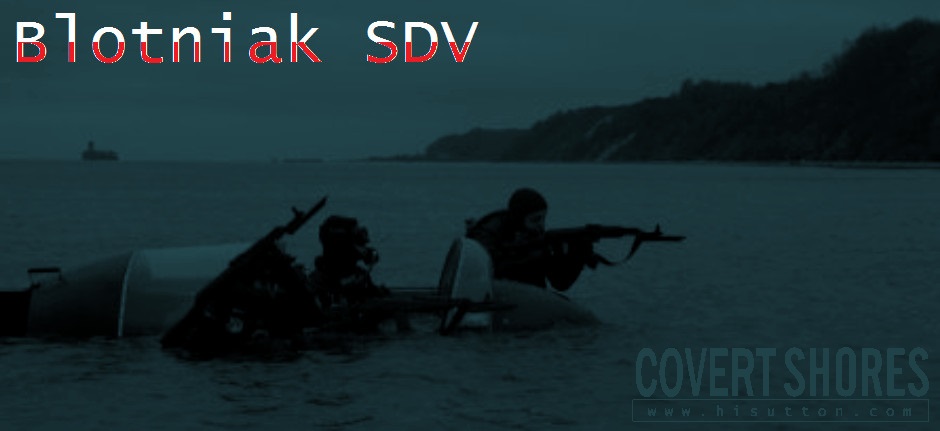 Background based on original photo from Blotniak.com.pl
Background based on original photo from Blotniak.com.pl
 Swimmer Delivery Vehicles (SDVs) solve the problem of transporting a diver greater distances than is possible by swimming. There have been hundreds of types over the years (mainly forgotten) so it is inevitable that most are easily categorized into distinct sub-groups or families. In the SDV evolutionary tree there is only one instance of a single-person fully enclosed SDV. They are ordinarily multi-person because combat swimmers normally operate in pairs for safety and to share the workload of navigating and piloting the craft. Smaller single-person Diver Propulsion Vehicles (DPVs) on the other hand are also quite common but they are not enclosed as one of their core requirements is compactness and ease of manhandling.
Swimmer Delivery Vehicles (SDVs) solve the problem of transporting a diver greater distances than is possible by swimming. There have been hundreds of types over the years (mainly forgotten) so it is inevitable that most are easily categorized into distinct sub-groups or families. In the SDV evolutionary tree there is only one instance of a single-person fully enclosed SDV. They are ordinarily multi-person because combat swimmers normally operate in pairs for safety and to share the workload of navigating and piloting the craft. Smaller single-person Diver Propulsion Vehicles (DPVs) on the other hand are also quite common but they are not enclosed as one of their core requirements is compactness and ease of manhandling.
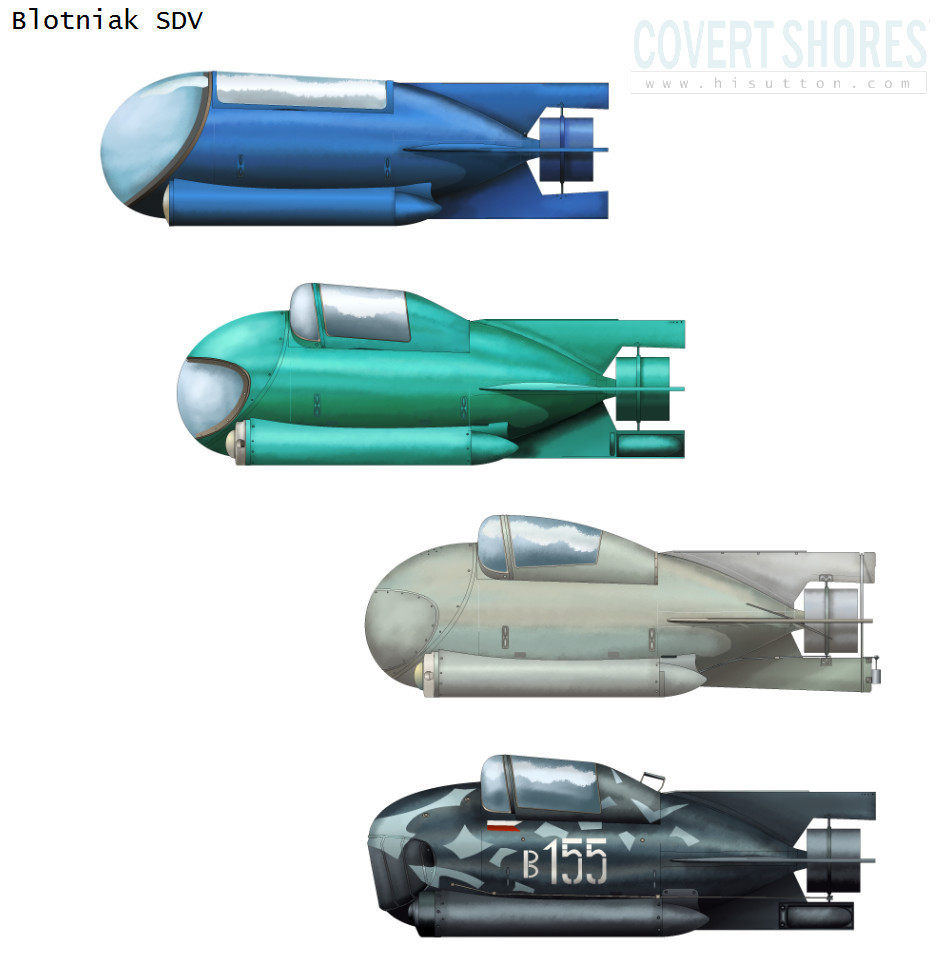
When the Polish Navy created its frogman special forces unit (called Formoza) in 1975 they went about things in a thoroughly independent way. Although part of the WARPAC, they did not leverage either the Soviets (Spetsnaz) or East German's (KSK-18) underwater vehicles. Development of the indigenous Blotniak (meaning Marsh Harrier) started in the 1970s at the Naval University of Gdynia, Poland under a veil of secrecy. From 1978 work was carried out at the Institute of Ship Construction and Propulsion under the leadership of Prof. Wladyslaw Wojnowski. The development team composed of Commander J. Biegalski, Captain A Domiszewski, B. Jakus, Captain M. Pleszewski and Commander B. Sowe.
There are at least four surviving examples in existence (out of eight built) and which tell the story of development. The type was equipped with a Polish designed Hydro-locator pointing to a defensive role countering enemy combat swimmers in Polish or WARPAC ports.
In the first version the pilot lay prone, looking out through a clear perspex nose. The overall craft was just 3.5m (11f) long and shaped like a tear-drop. Another unusual feature was that there were no control surfaces. Instead a steerable shroud was fitted around the twin contra-rotating propellers. To simplify design the propellers themselves didn't move, only the shroud which acted like a pumpjet. Silver-Zink batteries were housed in sealed containers either side of the hull with two 100 watt headlamps in front providing visibility of about 5 meters underwater.
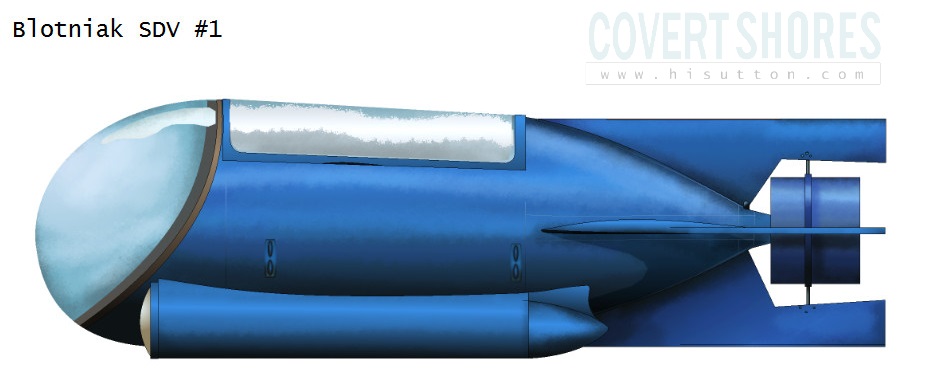
Two Blotniaks could be attached side-by-side with the crew communicating via a Palma diver communication system. The vehicle was also intended to be air-droppable without a parachute from a helicopter hovering at very low altitude (~5 meters) above the surface of the water.
The ultimate book of Special Forces subs Covert Shores 2nd Edition is the ONLY world history of naval Special Forces, their missions and their specialist vehicles. SEALs, SBS, COMSUBIN, Sh-13, Spetsnaz, Kampfschwimmers, Commando Hubert, 4RR and many more.
Check it out on Amazon

Photos from Blotniak.com.pl
Specifications
Length: 3.5 meters
Speed: 3-5 knots
Operating depth: 50 meters
Crew: 1
Range: 13 nautical miles (25 km)
Armament: none
Payload: ability to tow two divers or a 5-10 meter long cargo pod
Precursors
It is sometimes helpful to examine prior vehicles with similar design features or parallel solutions to a problem. The obvious precursor from a Polish perspective is the Żywe torpedy ('living torpedo') of WW2. In 1939 with war with Nazi Germany imminent, the Polish government sought volunteers to steer 'living torpedoes' into the invader's ships. The program was real but there is no evidence that the devices were actually built or put into service, or indeed what they looked like. Poles have done a great job of researching this topic but unfortunately any answers were destroyed by the war. All we can really say was that it was single-person and had some commonality or resemblance to a torpedo. Although the history may have been an influence, clearly the Blotniak is not at all related in design terms.

Popular depictions of the Żywe torpedy from Polish sources
Closer in design terms was the enclosed version of the Rebikoff Pegasus. This 1960s vehicle has a passing resemblance but is actually quite different in key respects.Demitri Rebikoff was a French underwater vehicle pioneer whose most successful creation was the Pegasus series of DPV. This was a single man craft which resembled small torpedo with the frogman laying on top. A separate cylindrical pressure container housed the instruments in front of the diver's face and there were large hydroplanes mounted near the front. First built in the 1950s, an enclosed version was developed in the 1960s. An important difference was that it was a casing built around a self-contained DPV, whereas in the Blotniak the casing was integral to the craft. Another notable difference was the forward hydroplanes, which were a major feature of the Pegasus (it 'flew' through the water) but absent on the Blotniak.
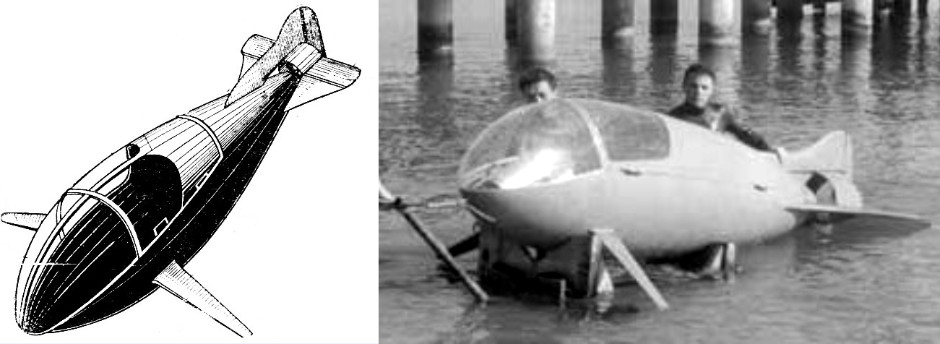
The Pegasus can be viewed as quite successful but the enclosed version never caught on. It is possible that the Pegasus was an influence in the Blotniak concept phase but there seems no strong family relationship.
Other than that there aren't any obvious candidates. We could expand the filters to single man craft like the British 'Sleeping Beauty' but that was of course not enclosed.
Blotniak #2
Laying down is often thought of as more comfortable for longer journeys but it is less comfortable and less practical when running awash on the surface. Experiments with the Blotniak in the cold waters of the Baltic found that the diver laying prone got muscle cramps so it is not surprising then that the second prototype was configured for the diver to drive in a seated position. The overall length of the craft was unaltered, but the sliding hatch on the top was remodelled as an aircraft-like cockpit canopy. The glazed nose remained but the size of the window was made much smaller.
Performance was still an impressive 5kts which is about 5 times faster than a swimmer. Cruising speed was a more modest 3kts which is still much faster than a swimmer.
If a greater payload was needed the Blotniak could tow a container or, it seems, a mine. It could also tow additional divers although these would be exposed.
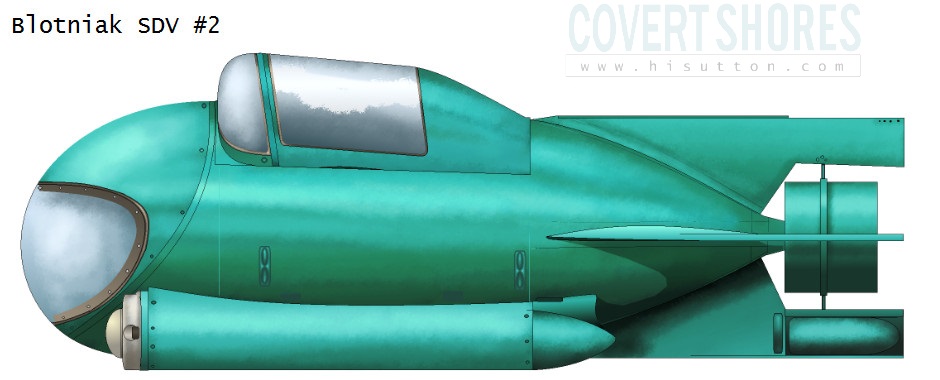

Photos from Blotniak.com.pl
Blotniak #3 ('003')
A resurgence of interest in the Blotniak in the 2000s created two faithful replicas. The first is often painted as '003' and is distinguishable from the others by having moving hydroplanes at the rear, a frame reinforcing the stabilizers and a hanging weight mounted on the lower tail section. In its current state this replica does not appear seaworthy.
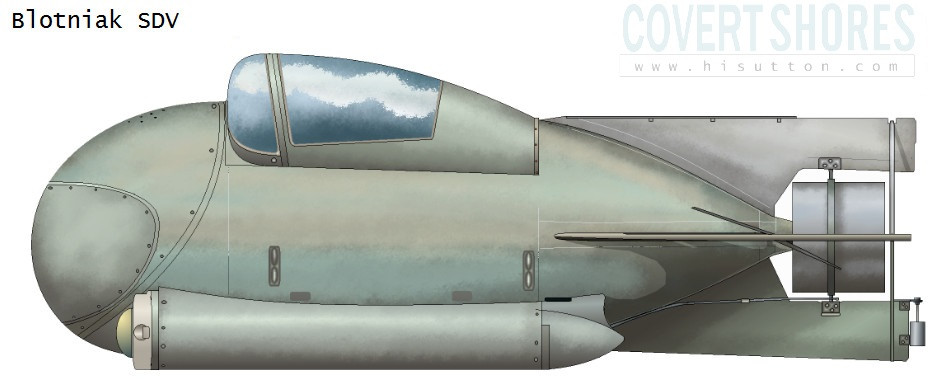
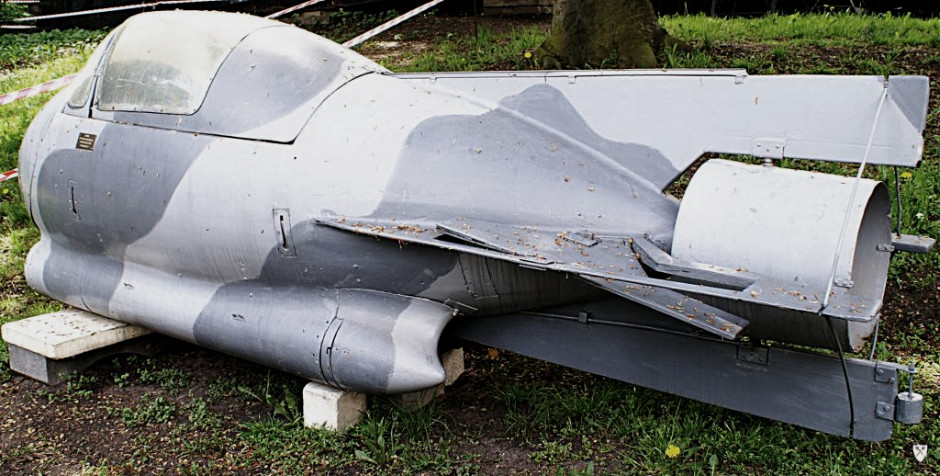
Photo by Topory, Wikipedia
Blotniak #4 ('B-155')
Extensively rebuilt with modern components by its ower Mariusz Szymański, this is the only fully functional craft and is by far the most photographed example.
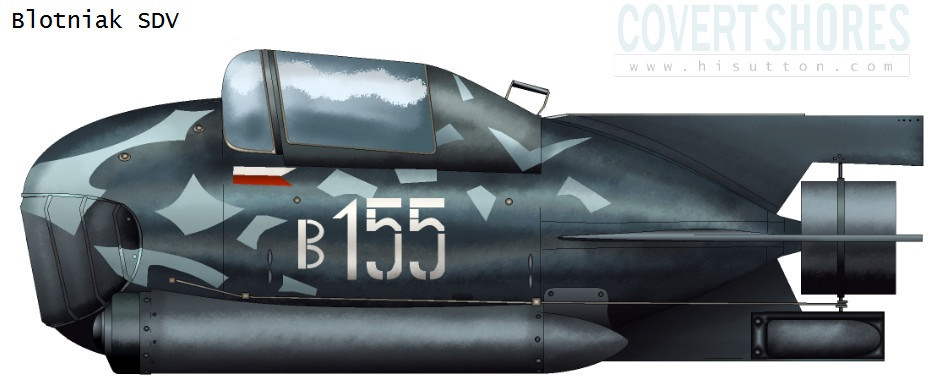

Today
Today Polish Special Forces use the US made Stidd DPD (Diver Propulsion Device), a 1-2 man craft where the swimmer(s) is exposed to the water.
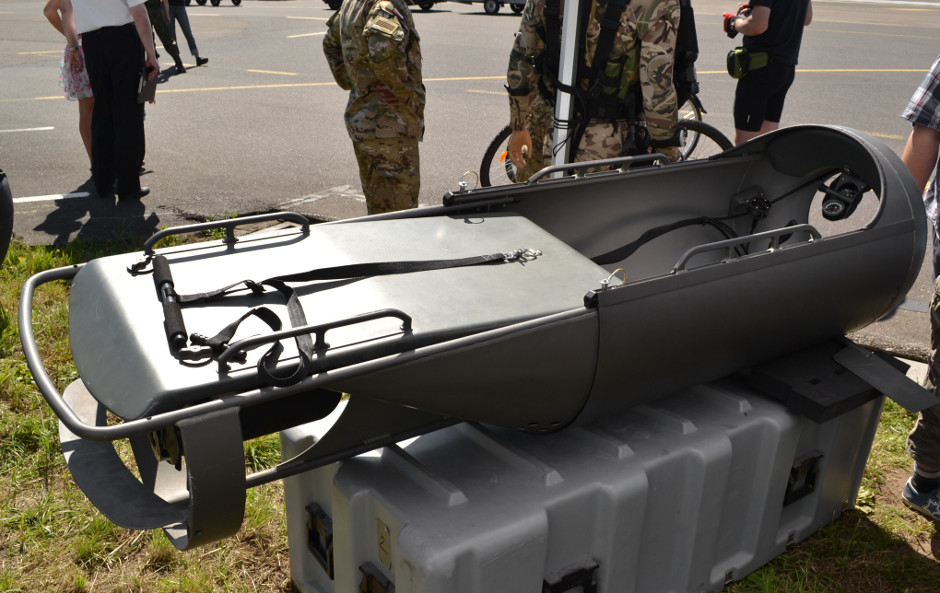

Related Articles

 SDV Mk.9 SEAL Delivery Vehicle
SDV Mk.9 SEAL Delivery Vehicle

 DGSE's SDVs
DGSE's SDVs

 Narwal / Orca Dry Combat Submersible (UWTG)
Narwal / Orca Dry Combat Submersible (UWTG)

 Naval Spetsnaz in Hybrid Warfare (Russian SDVs and DPVs)
Naval Spetsnaz in Hybrid Warfare (Russian SDVs and DPVs)

 Rotinor BlackShadow 730 and Divejet 414 Diver Propulsion Vehicles
Rotinor BlackShadow 730 and Divejet 414 Diver Propulsion Vehicles

 Bonex HP and HP Shuttle Diver Propulsion Vehicles
Bonex HP and HP Shuttle Diver Propulsion Vehicles

 Vogo DPD-200 diver propulsion device
Vogo DPD-200 diver propulsion device

 Ortega Mk.1 Swimmer Delivery Vehicle
Ortega Mk.1 Swimmer Delivery Vehicle

 Triton-NN Submersible Boat
Triton-NN Submersible Boat


 Marex Type-A (A2, A4, A5, Comex Total-Sub-01) SDVs
Marex Type-A (A2, A4, A5, Comex Total-Sub-01) SDVs

